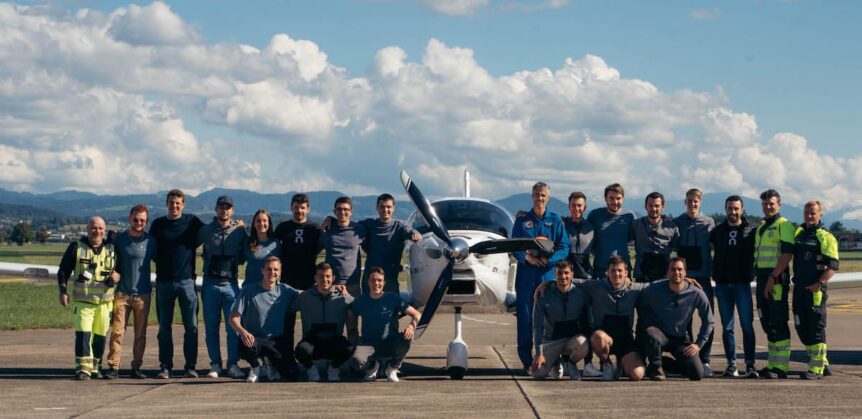Two groups of students, AeroDelft in The Netherlands and ETH Cellsius in Switzerland, are making great progress on some extremely advanced aeronautical projects. Each school’s ultimate goal seems to be flying with liquid hydrogen, and each has a slightly different approach to that goal.
AeroDelft: Starting Small
AeroDelft, the student-led project at Delft University of Technology, flew a 1/3 scale model that closely resembles e-Genius in July. Its 1,500 Watt (two kilowatt) motor is powered by 40 grams (1.411 ounces) of gaseous hydrogen initially, but will transition to liquid H2 later in the program. 380 grams (13.4 ounces) of the more potent fuel will allow three hours endurance and a range of almost 300 kilometers (186 miles)
Since that flight, the team has exhibited at various trade shows and advanced work on its Sling 4 two-seat light aircraft. The 920 kilogram (2,024 pound) maximum takeoff weight aircraft, powered by a 110 kilowatt (147.4 horsepower) motor flies on battery power for now. In 2024, the team hopes to fly on 1.45 kilograms (3.19 pounds) of gaseous hydrogen fueling a 125 kW fuel cell, followed in 2025 with liquid H2. The latter will provide two hours endurance and 400 kilometers (248 miles) range.
The team explains their choice of hydrogen as a fuel, defining three main choices for sustainable aircraft power: kerosene equivalents, batteries, and hydrogen. They disavow biofuels and synthetic kerosene as “not sustainable in the long term.” Nitrogen oxide (NOx) emissions from their combustion is “up to 4.4 times higher than the impact of CO2 emissions on the environment.” And batteries are too heavy.
The team looks to hydrogen in gas and liquid form to be a long-term solution, noting that a single wind turbine could produce the electricity to produce enough H2 for a commercial aircraft. They see hydrogen as an answer not only for aviation, but for transportation over all, “leading to a sustainable, future hydrogen economy.”
AeroDelft ends with a pronouncement of hope. “Although our aircraft are small, our ambition is not. For example, we are working internationally to develop certification guidelines for hydrogen propulsion. We firmly believe that our work will impact and inspire the future of the aviation industry.”
ETH E-Sling: Batteries First
ETH students built their E-Sling over the past two years and managed a test flight on battery power on September 19, 2022 as part of their Cellsius Project.
The airplane, propelled by a radial flux motor from E+A, a Swiss firm, produced a take-off power of 110 kilowatts (147.4 horsepower) at 2,300 RPM. E+A claims a torque-to-weight ratio of 24 Nm/kg (8 foot-pounds per pound) and a power-to-weight ratio of 5 kW/kg (3 hp. per pound).
Moving to Hydrogen
ETH students designed a modular battery system installed in the leading edge of the wings. They claim their E-Sling is the first electric aircraft to be equipped with a modular battery system, enabling the batteries to “be exchanged during a stopover – although in practice this currently takes some time.” The battery packs have an energy density of 196 Watt-hours per kilogram, good as that claimed for many currently flying examples.
Moving on from the 44 kW/hr. batteries, the four-seater has a range of 180 kilometers (112 miles), a short hop for its 185 kilometer per hour (115 mph) cruising speed. Hydrogen in gas or liquid form will help make the E-Sling more of a cross-country cruiser.
To ensure their efforts don’t go away after the current group of students graduate, “The previous year’s students hand over the project to a new group of students each year, like in a relay. The third group of students has just taken the project over.”
A Small H2 Test Craft
To test their hydrogen power system, the students are putting together a smaller craft, the Swiss Lightwing AC4, normally powered by the ubiquitous Rotax 912 engine. Students will design and build most of the powerplant components. As they note on their web site, “Our developments range from the design of the pressure tank to the development of our own high-performance inverter to your own electric motor.” The project “will design and manufacture the radial flux motor ourselves in partnership with e+a.”
Their specifications show they anticipate a seven kilogram (15.4 pound) motor that will develop 75 kilowatts (100 hp.). A small 648 Volt battery pack aft of the firewall will deliver 5.8 kilowatt hours of back-up electricity. A 280-plate, 68-kilogram (149.6-pound) fuel cell will deliver a nominal 65 kilowatts (87hp.). 700-bar (10,150 pounds per square inch) pressure tanks will hold 8 kilograms of H2.
Two Outstanding Projects
Two groups of students have managed to accomplish breakthroughs that would make full-scale design and manufacturing firms proud. We hope to see further successes from both groups.

